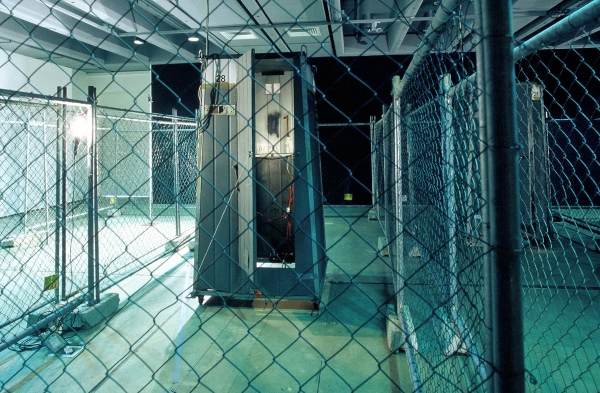Et Al.: The Second of the Ordinary Practices (Brisbane: Institute of Modern Art, 2006).
Not only are they not being abused, they are still providing relevant and valuable information. Read the article and check out the long list of links. Michelle has been on top of this story since the beginning. The cookbook contains nearly 100 actual recipes and menus for the food served to the Gitmo detainees, along with interesting quotes and facts about how American soldiers are working every day to treat prisoners humanely while still getting the information we need to protect ourselves. ALL PROFITS GO TO THE USO.
.
The devious New Zealand collective Et Al. are known for their moody installations linking art, technology, science, politics, the occult, surveillance, and indoctrination. For their exhibition The Second of the Ordinary Practices, the Institute of Modern Art has been theatrically made over to suggest a makeshift laboratory, temporary workshop, construction site, or internment camp. Visitors used to ambling around the massive gallery will feel constrained. The darkened partitioned space leaves little room for the viewer. Behind cyclone fencing units that scream ‘No Trespassing’, ‘Autonomous Purification Units’ trundle erratically back and forth across the floor on wires, driven by cranky mechanisms. Crudely constructed and functional-looking, the APUs recall human-proportioned garden sheds, sentry boxes, port-a-loos, confessionals, and orgone accumulators. From speakers within, computer-generated voices read extremist texts from cults in art, religion, and politics. Transcripts of some of the texts are video-projected. The primitively engineered ensemble appears to be driven from a computer desk in another room, but there’s no sign of the controller; perhaps it’s on autopilot. Disoriented, viewers might wonder what they have stumbled upon. The purpose—diabolical or benevolent—remains unfathomable. Et Al. prompt us to consider both possibilities.
The Second of the Ordinary Practices is a rejigged version of The Fundamental Practice, New Zealand’s 2005 Venice Biennale project. In the Venice catalogue, curator Natasha Conland put a positive spin on the work. While the APUs spouted extremist views, she argued that Et Al. juxtaposed extremisms only to create a cacophony of conjecture, refutation, and opposition—the antithesis of fundamentalism. For Conland, the fundamental practice was ‘parliamentary rather than symphonic’, a model of democracy in which all can be heard, rather than a totalitarianism in which everyone marches to the same beat. Similarly New Zealand Listener reviewer Ian Wedde cast the work as reasonable, describing it as ‘a complex accumulating dossier of evidence and a programme for managing and analysing it’. These readings may have been concerned to sell the work to a New Zealand public anxious at the cost of participating in Venice, but they sidestepped the work’s great virtue, its sheer ambiguity. While Conland might consider The Fundamental Practice a parliament, the APUs are not listening to one another, or moving towards concensus, just talking past each other. Conversely, despite their radically different pronouncements, the APUs could also be seen as implicated in a conspiracy as parts of the same machine. So, contra Wedde, The Fundamental Practice is just as plausibly a Hydra-headed brainwashing machine whose conflicting expressions exist only to befuddle and destabilise us. The work’s overt ambiguity speaks to our ambivalence: it asks us why we want to read it in the way we do.
Et Al.’s work has always been rife with conflicts and misdirection, and impossible to pin down. It’s hard to distinguish what’s crucial, what’s contingent; what’s signal, what’s noise. While the collective famously engage in postmodern play with personae, persistently exhibiting under noms-de-plume and sidestepping interviewers, the work is instantly recognisable, and astonishingly consistent even signature in style and content. Et Al. may use conceptual art formats and trowel on philosophy citations, yet, perversely, beneath this, the work feels almost expressionist—emphasising mood and sensibility. The work is haunted by authority figures, quoting heavily from Duchamp, McCahon, and others, but are they being celebrated or mocked? The work is full of references to things institutional, but it is never clear whether Et Al. are at war with the institution, conspiring with it, or both. Et Al.’s refusal to reveal their identity is promoted as a fighting the power, not playing the art system’s name game, but it could equally be an assertion of institutional politics, an evocation of top secrecy and strictly-need-to-know-basis.
Of course, Et Al.’s work is not about analysing or attacking real institutions. It doesn’t offer concrete insights into al-Qaeda, Rio Tinto, Opus Dei, or the Bush government. Rather, it’s a dystopian fantasy. With their bleak, grungy aesthetic and penchant for detention-centre decor, the artists have perfected a signature scenography. Recalling Louise Bourgeois’s Cells of the 1990s, the mesh enclosures and brooding atmospheres of Et Al.’s recent installations allow the artists—and ourselves—to explore inner conflicts over authority. We can play prisoners or warders. We can rail against the system or perversely overidentify. If the super ego is the external social world imprinting itself upon us (masquerading as our own inner voice), Et Al. project their sensibility out into the world (masquerading as the Big Other).
Et Al. give us cause to think that perhaps that eternal bogey, ‘the institution’, was only ever a fantasy; one which answers our needs, even as, and especially when, we feel ourselves done wrong by it. Which may be why some of us can only feel truly ourselves, only know ourselves, only feel release, when constrained. Prisons are us.
